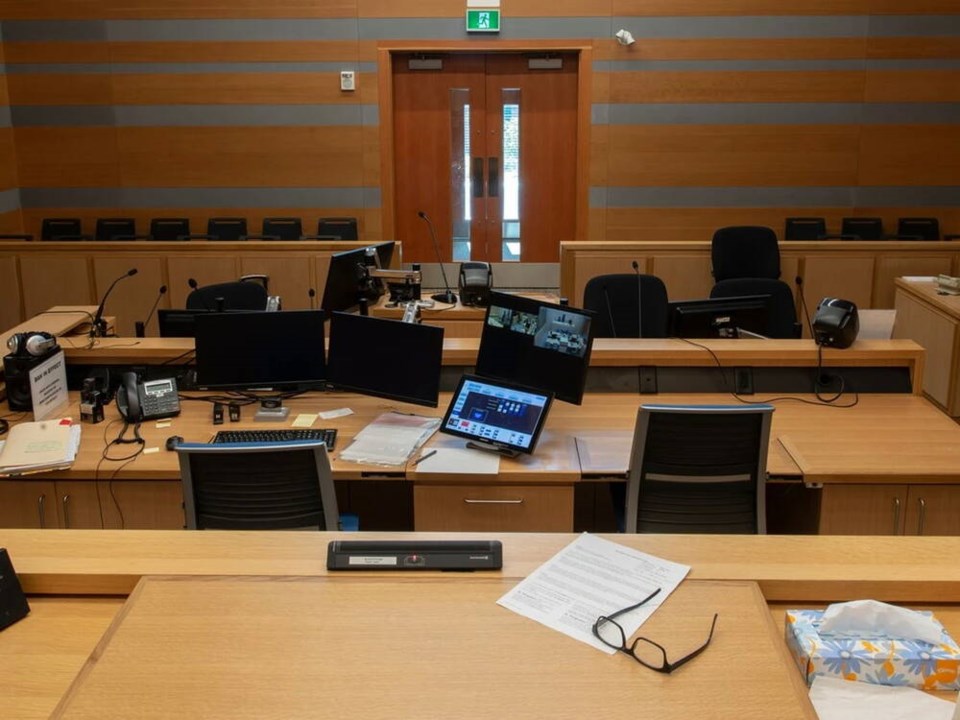More than 250 formal complaints were filed against judges and other officers of the B.C. provincial court during the 2022-23 fiscal year, with 10 examined by the court’s chief judge and resolved, according to the court’s annual report.
A majority of the complaints, 233 of them, were determined not to involve judicial misconduct and in most cases individuals were given information about the appeal process, the report said. Some complaints didn’t relate to the court and were referred elsewhere, it said.
Of the 10 complaints examined by Chief Judge Melissa Gillespie, five were against judges, one was against a judicial justice (who hears minor trials, such as those involving traffic, ticket and bylaw infractions), two were against justices of the peace (who hear simplified civil trials) and two were against judicial case managers (who schedule trials and preside over first appearance and assignment courts), according to a summary of complaints in the report.
Gillespie had to decide whether they had merit, could be resolved through remedial or corrective measures, or warranted an investigation, it said. Since 2013, all but one complaint, in 2017, have been resolved after being examined by the chief judge, it said.
The report, which didn’t name the judicial officers involved, included details of the complaints, including one judge in a family law matter who “expressed regret for their conduct” and “apologized for their tone during the proceedings.” The complainant had alleged he or she was biased, “snapped” at the complainant, disrespected them and wouldn’t let their lawyer speak.
The assertions of bias against the judge were dismissed, but a review of the hearing’s audio recording showed the “judge’s serenity was at times broken,” the report said.
Judges must remain calm and serene, even in challenging circumstances, to show justice is being exercised fairly and even-handedly, the report said.
Another judge, accused of making a “racist” comment, was told he or she should have avoided the wording used because it “could reasonably be interpreted to be based on a racial or cultural stereotype,” the report said. The matter was resolved when the judge “expressed regret at how their words were perceived by the complainant” and clarified how they intended the comments, the report said.
Judges “should avoid comments, expressions, gestures or behaviour which reasonably may be interpreted as showing insensitivity to or disrespect for anyone,” as required by the Canadian Judicial Council’s ethical principles for judges, the report said.
Another complaint alleging a judge “drives dangerously” and intended to “intimidate” the complainant was closed after the judge denied the allegations and it couldn’t be “fairly concluded” the judge did anything wrong, according to the report.
Another complainant received a “sincere apology” from a judicial justice after a complaint suggesting the official “breaks the law all the time,” according to the report.
The judicial justice “did state that they break the law when travelling even one kilometre” over the speed limit and that comment was of “concern” as it relates to integrity and impartiality as set out in the ethical principles, the report said.
The judicial justice said he didn’t intend to say he frequently broke the law by speeding and “expressed regret at their choice of words,” it said.
The matter was closed after the judicial justice was given a letter “reminding them of the ideals to which judges and justices aspire” and of how comments can be perceived by the public, it said.
Another complainant asserted a justice of the peace abused their authority, had a substance abuse issue, uttered threats, violated a no-contact order and engaged in conduct for which the complainant called police.
The two had “very different recollections of what was said and done in relation to the events complained of, and the complaint stemmed from interpersonal issues, which could not be resolved within the context and process of a complaint about judicial conduct” and the matter was closed, the report said.
A complaint against a justice of the peace was resolved when he or she had a photo removed from the internet and was “directed to review educational materials related to judicial conduct and social media use,” the report said.
The complaint arose after “it was brought to the attention of this office that an image of an intimate nature of a justice of the peace was posted on social media,” the report said.
The justice of the peace’s swift action led to the matter being closed, it said.



